Cape Verde Weather: An Ultimate Guide
Explore the climate and seasonal weather of Cape Verde, an enchanting tropical archipelago and popular holiday destination
Powered by Sun, Sand and No Stress
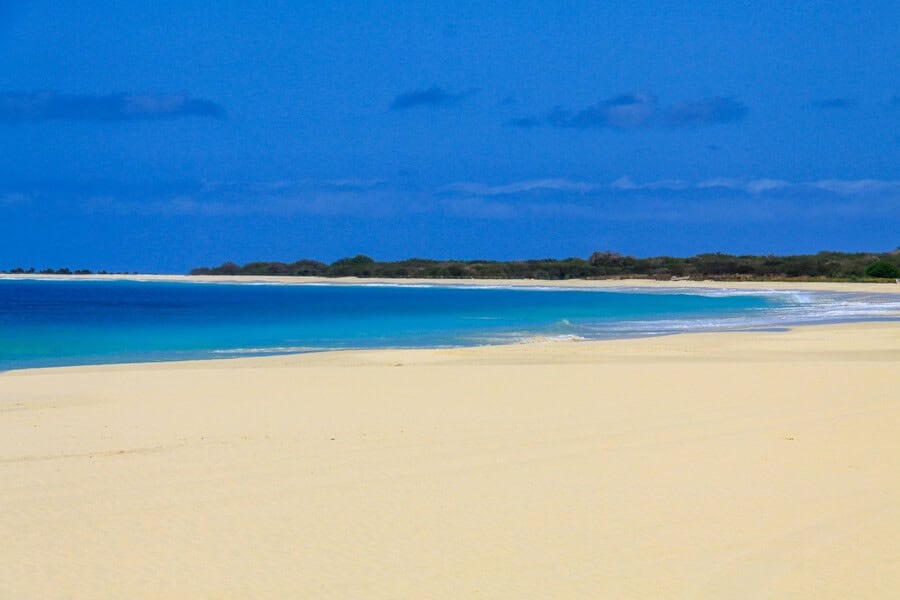
"Cape Verde, a small archipelago with boundless spirit, where the winds of change have sculpted a land of endless possibilities, reminding us that even the smallest of places can leave the biggest impact on our hearts."
Tchek
CAPE VERDE EXPLORER
Nestled within the azure expanse of the Atlantic Ocean, the Cape Verde archipelago emerges as a jewel of diverse topography and equally varied climatic experiences. Recognised for its quintessentially dry tropical climate, Cape Verde boasts temperate conditions complemented by a revitalising maritime breeze that sweeps across the islands perennially. The Cape Verde Islands have two main seasons: a temperate dry season and a slightly wetter season. Below is a general guide to the typical weather in Cape Verde for each month of the year.
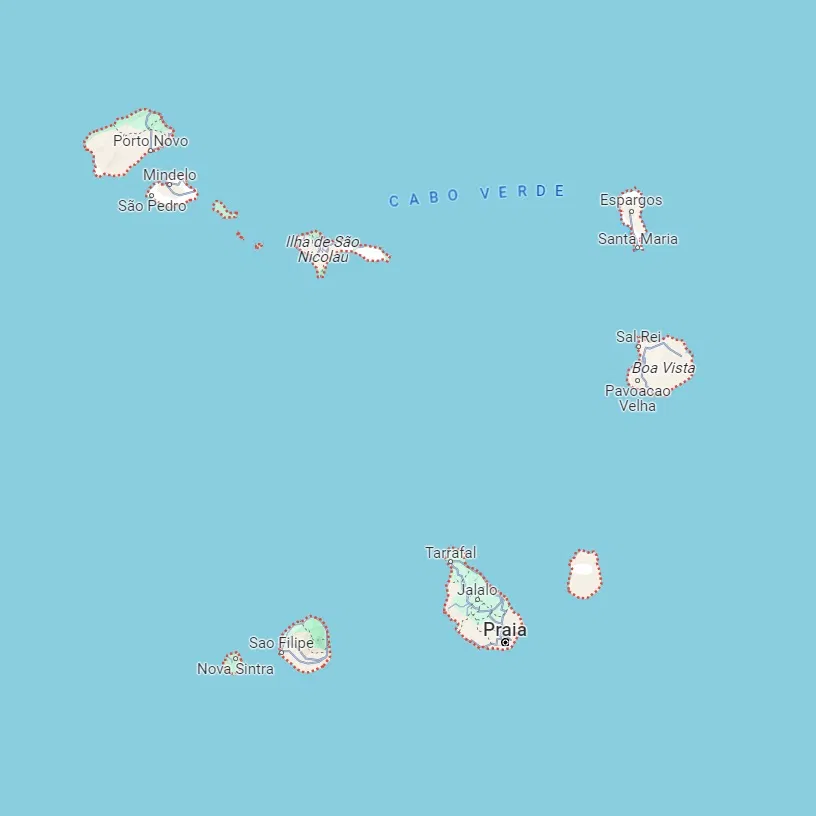
Google Maps: Cape Verde Map
Monthly Weather Overview
- Average temperature: Jan 25, Feb 25, Mar 26, Apr 26, May 27, Jun 27, Jul 28, Aug 29, Sep 30, Oct 29, Nov 28, Dec 26
- Average sea temperature: Jan 23, Feb 23, Mar 23, Apr 23, May 23, Jun 24, Jul 26, Aug 27, Sep 27, Oct 27, Nov 26, Dec 25
- Sunshine hours: Jan 8, Feb 9, Mar 10, Apr 10, May 10, Jun 8, Jul 7, Aug 6, Sep 8, Oct 8, Nov 9, Dec 8
- Days of rain: Jan 0, Feb 0, Mar 0, Apr 0, May 0, Jun 2, Jul 3, Aug 3, Sep 6, Oct 4, Nov 1, Dec 0
Quick Links
Cape Verde Weather in January
January in Cape Verde is part of the archipelago's dry season, known for its lower humidity and milder temperatures compared to the wetter months. This makes January an agreeable time for holidaymakers, with weather conditions that are generally pleasant and suitable for a range of pursuits.

Daytime temperatures in January typically average around 25°C (77°F), providing a warm but not excessively hot climate. This is ideal for sightseeing or enjoying the beaches without the more intense heat experienced later in the year.
Night-time temperatures drop to an average of 19°C (66°F), which many find refreshing, particularly for sleeping. It's sensible for visitors to pack a light jumper or cardigan for evenings out, especially when near the coast where it can feel cooler due to the sea breezes.
January Precipitation
Rainfall in January is quite scarce, as this month falls within Cape Verde's arid season. The islands see a low likelihood of rain, with any showers tending to be short-lived and light.
The scanty rainfall contributes to the predominantly sunny weather, with clear skies being typical throughout the month.
January Sea Temperature
The sea temperature around the islands in January is on the cooler side, averaging about 23°C (73°F). Whilst this might be slightly brisk for some bathers, it remains agreeable for most and quite invigorating on a balmy day.
Water sports aficionados, particularly those keen on wind sports such as windsurfing or kiteboarding, will find these conditions to their liking as they often don wetsuits which provide warmth from the cooler waters.
January Winds
The Northeast trade winds are a salient feature of Cape Verde's climate in January. These breezes are generally steady and can sometimes be quite brisk.
The prevalence of these trade winds is particularly alluring to those interested in wind sports. Islands like Sal and Boa Vista become hotspots for surfing, windsurfing and kiteboarding during this time owing to the superb wind conditions and strong waves.
January Sunlight and UV Exposure
Clear skies are an almost daily occurrence in January, leading to ample sunlight. Visitors can expect generous amounts of sunshine, which necessitates adequate sun protection measures such as high SPF sunscreen, brimmed hats, and UV-blocking sunglasses.
Despite being a cooler month, the UV index can still be high due to Cape Verde's proximity to the Equator. Holidaymakers need to take regular breaks from direct sun exposure, particularly during midday hours when the sun is at its strongest.
January Overall Climate
The amalgamation of warm days, cooler nights, minimal rainfall, persistent trade winds, and moderate sea temperatures make January an inviting month for a diverse array of activities. Visitors can relish outdoor activities such as trekking, birdwatching, sightseeing, and various water sports.
The climate also permits comfortable exploration of Cape Verde's cultural offerings, including its music, dance, and festivals without the excessive heat that can occur at other times of the year.
For those planning a visit to Cape Verde in January, it's wise to pack lightweight clothing for the daytime, some warmer garments for the evening, swimwear, and perhaps a wetsuit if planning to engage in extended water activities. Sun protection is also recommended owing to the substantial periods of sunshine one is likely to enjoy.
Cape Verde Weather in February
February in Cape Verde is marked by a climate that closely mirrors the conditions experienced in January, falling within the cooler and drier segment of the year. The archipelago's weather at this time is characterised by a stability that makes it especially appealing for visitors seeking winter sunshine.
February Temperature
Daytime temperatures continue to be comfortable, with highs typically around 25°C (77°F). This warmth is ample for beach-going, swimming, and outdoor activities without the discomfort of sweltering heat.
Night-time temperatures remain mild, with averages around 19°C (66°F). This dip provides a pleasant coolness after sunset, making it advisable for holidaymakers to include some long-sleeved attire or light knitwear in their packing for the evenings.
February Precipitation
February maintains the dry trend with very little rainfall, continuing from January. Precipitation is rare, and when it does occur, it is generally in the form of brief, light showers that do little to disrupt outdoor plans.
The scarcity of rain results in mostly clear skies throughout the month, ensuring an abundance of sunny days perfect for capturing holiday photographs and enjoying uninterrupted views of the island's landscapes.
February Sea Temperature
The sea temperature in February is consistent with January, hovering around 23°C. For some, this may be considered slightly fresh, but it is often viewed as refreshing, especially when participating in vigorous water sports.
With the sea temperature remaining inviting for water-based activities, visitors can indulge in snorkelling, diving, and sailing. Those engaging in extended periods of water exposure might still appreciate a wetsuit for added comfort.
February Winds
The Northeast trade winds persist through February, maintaining their presence as a defining characteristic of the season. These winds can be particularly robust, making for excellent conditions for sailing and wind-propelled sports.
The islands of Sal and Boa Vista continue to draw enthusiasts of windsurfing and kiteboarding due to their favourable wind conditions. The steady breeze also helps to temper the daytime heat and keep mosquitoes at bay.
February Sunshine and Daylight
With the dry season at its peak, sunshine is abundant, and daylight hours are long, allowing visitors to maximise their time spent outdoors whether it's lounging on the beach or exploring the cultural heritage of the islands.
The angle of the sun at this latitude ensures that UV exposure can be strong even in February, so high-factor sunscreen, hats, and protective clothing are essential.
February Overall Experience
The consistent weather conditions make February an opportune time to experience the various festivals and events that take place throughout the islands, where the temperate climate enhances enjoyment.
The natural beauty of Cape Verde can be fully appreciated during this month, from its volcanic peaks and verdant valleys to its charming coastal villages and vibrant markets.
For travellers planning a February getaway to Cape Verde, it's recommended to pack a variety of clothing options that can be layered. Essentials should include items suitable for warm days as well as cooler evenings. Additionally, holidaymakers should prepare for outdoor activities with appropriate gear and sun protection to take full advantage of the favourable weather conditions.
Cape Verde Weather in March
March in Cape Verde represents the transition from the cooler winter months to the more temperate spring season, offering a delightful climate for visitors. The archipelago enjoys a subtropical dry climate, influenced by its location in the Atlantic Ocean off the coast of West Africa.
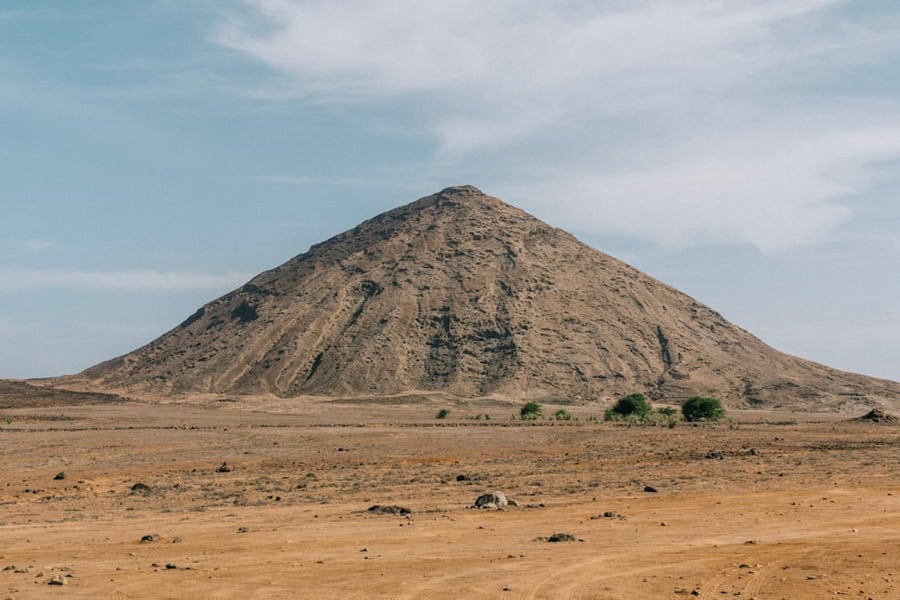
Photo by Krisztian Tabori
March Temperature Trends
Daytime temperatures exhibit a slight increase from the preceding months, with averages around 26°C (79°F). This increment in warmth signals the gradual approach of the warmer season, yet remains comfortable for tourists seeking sun without extreme heat.
Night-time temperatures are also on a gentle upward trend, averaging about 20°C (68°F). This minor increase keeps evenings pleasantly mild, perfect for enjoying al fresco dining or late-night strolls along the beaches.
March Wind Activity
The Northeast trade winds persist through March, though they may begin to lessen in intensity as the month progresses. These winds continue to provide excellent conditions for wind-powered sports, with enthusiasts of windsurfing and kitesurfing finding ideal circumstances for their pursuits.
The trade winds also play a role in tempering the warmer daytime temperatures, creating a refreshing breeze that can be especially appreciated during peak sunshine hours.
March Dry Season Continuation
March maintains the dry conditions characteristic of Cape Verde's climate at this time of year. Rainfall remains minimal, with the islands experiencing extended periods of arid conditions.
The lack of significant precipitation ensures that outdoor activities remain largely uninterrupted by wet weather and that the terrain retains its dry-season landscape features.
March Ocean Conditions
Sea temperatures in March begin to rise slightly, which may encourage more swimming and water activities among visitors. The waters around Cape Verde are known for their rich marine biodiversity, making this an opportune time for snorkelling and diving to observe sea life.
For those participating in extended water sessions, such as surfers or long-distance swimmers, the sea's warmth is a welcoming change from the slightly cooler waters experienced during the winter months.
March Sunshine and Daylight Hours
Sunshine remains abundant in March, with Cape Verde enjoying one of the highest rates of daylight hours in the region. This ensures ample opportunity to soak up vitamin D and relish in the outdoor lifestyle that the islands promote.
With clear skies being a frequent occurrence, visitors can expect to experience vast horizons and unobstructed views of Cape Verde's volcanic landscapes and azure waters.
March Natural Environment
The dry conditions contribute to the visibility of geological formations and desert-like scenery on some of the islands. For nature enthusiasts and photographers, the distinct shadows and contrasts during sunrise and sunset can be particularly striking.
Wildlife, particularly bird species that are endemic or migrate through Cape Verde, may be more visible as they congregate around limited water sources.
When visiting Cape Verde in March, pack lightweight clothing for the daytime, preferably made from breathable fabrics such as cotton or linen. Include a light jumper or jacket for the cooler evenings. Essential items are sun protection like hats, sunglasses, and high-factor sun cream due to strong UV levels. Water sports enthusiasts should consider bringing rash vests or wetsuits. Sturdy walking shoes are recommended for exploring both towns and nature trails. Remember your camera to capture the stunning landscapes and vibrant cultural scenes during this peak travel season in Cape Verde.
Cape Verde Weather in April
April in Cape Verde is a month of subtle transition, marking the gradual shift from the cooler, drier season into the warmer, more humid conditions that precede the rainy season. The islands' location in the Atlantic Ocean off the coast of Senegal ensures a maritime influence on the climate, with April featuring increasingly balmy days.
April Temperature Shifts
Daytime temperatures in April see a gentle increase, with averages now oscillating between 26°C (79°F) and 27°C (81°F). This slight uptick in warmth makes for very agreeable weather, particularly suitable for those looking to bask in the sun’s embrace without the more intense heat that characterises the summer months.
As darkness falls, night-time temperatures are consistent with this trend, resting between 20°C (68°F) and 21°C (70°F). The evenings remain comfortable, and while a light breeze may persist, it is rarely chill enough to warrant more than a light covering such as a shawl or a thin pullover.
April Rainfall and Humidity
Rainfall in April remains an uncommon occurrence, with dry conditions largely prevailing throughout the month. The rare showers that might present themselves are typically brief and light, doing little to dampen outdoor activities.
Humidity levels begin to climb as April progresses, heralding the approach of the more humid summer period. This increase is gradual and should not greatly affect comfort levels but may be noticeable compared to the arid conditions of previous months.
April Oceanic Influence
The Atlantic waters around Cape Verde continue to warm up through April, with sea temperatures becoming increasingly pleasant for those wishing to partake in water-based activities such as swimming, snorkelling, or boating.
The warmer sea temperatures can contribute to the slight rise in humidity levels, especially along coastal areas where sea breezes are common.
April Winds
While the Northeast trade winds are still present, their strength begins to diminish in April. This reduction in wind activity may be welcomed by those preferring calmer conditions for beach relaxation, surfing or leisurely sailing.
Nevertheless, there is often enough of a breeze for wind-dependent sports to remain enjoyable, though conditions might be less challenging for experienced windsurfers or kiteboarders than in previous months.
April Sun Exposure
With longer daylight hours and an abundance of sunshine, April offers ample opportunity for soaking up the sun. However, with the sun climbing higher in the sky, UV levels can be strong, and sun protection becomes increasingly important.
Ensuring adequate sun protection through broad-spectrum sunscreens, wide-brimmed hats, and quality sunglasses will be essential for preventing overexposure and enjoying the outdoors safely.
April Natural Landscape
April's mild weather is conducive to exploring Cape Verde's varied landscapes. From the lunar-like vistas of Pico do Fogo to the verdant valleys of Santo Antão, hikers and nature lovers will find the conditions excellent for full-day excursions.
The start of increased humidity can also bring a fresher appearance to some of the islands' flora, offering a contrast to the drier landscapes seen earlier in the year.
When visiting Cape Verde in April, pack a versatile wardrobe for warm days and cooler evenings. Include swimwear, cover-ups, and sun protection for seaside relaxation. Choose lightweight clothing for sun defence and a waterproof jacket for unexpected showers. Opt for moisture-wicking garments in humid areas and versatile footwear for varied terrains. Remember a hat, high-factor sun cream, and sunglasses for UV protection during your island adventures.
Cape Verde Weather in May
May in Cape Verde sees the continuation of the warming trend, as the archipelago moves closer to its summer season. The islands, scattered across the Atlantic Ocean off the western coast of Africa, are characterised by a climate that is both tropical and influenced by their maritime setting.

Photo by Dominique Josse
May Temperature Progression
Daytime temperatures further ascend into the higher twenties, with averages fluctuating between 27°C (81°F) and 28°C (82°F). This increase heralds the onset of early summer, providing warmth that is tangible yet not overwhelming, perfect for those seeking a sun-kissed retreat.
When the sun retreats, night-time temperatures hover around a balmy 21°C (70°F). This mildness is ideal for enjoying nocturnal activities, from waterfront dining to late-night walks under the stars.
May Marine Temperatures
The sea around Cape Verde takes on a noticeably warmer character in May, with water temperatures becoming ever more inviting for an array of aquatic pursuits. From leisurely swims to more adventurous water sports like jet skiing or deep-sea fishing, the conditions are optimal.
Warmer seas also encourage marine life activity, which can be a boon for snorkellers and divers keen to observe the vibrant underwater ecosystems that Cape Verde is renowned for.
May Climbing Humidity
As May progresses, humidity levels incrementally rise across the islands. While still not at the peak levels seen later in the summer months, the increase in moisture in the air can be felt, especially in areas with less wind exposure.
Despite the increased humidity, rainfall remains sparse, with the dry spell continuing and any precipitation that does occur typically being short-lived and inconsequential to most holiday plans.
May Wind Patterns
The once persistent Northeast trade winds begin to subside in May, leading to calmer conditions that may be particularly welcomed by those looking for tranquil seas and relaxed sailing experiences.
The diminished winds also mean that beaches are often more sheltered, creating idyllic settings for sunbathing and beach games.
May Sunshine Duration
Cape Verde enjoys an abundance of sunshine during May, with long days that stretch out to provide extensive periods for outdoor activities. Visitors can expect to experience up to ten hours of daylight.
With the sun reaching a higher zenith in the sky, UV levels are elevated. Visitors must take sun safety seriously, employing a rigorous regime of high SPF sunscreen reapplication, wearing protective clothing and seeking shade during the midday hours when the sun’s rays are most direct.
May Flora and Fauna
The slight increase in humidity begins to have a visible effect on the islands' landscapes. Vegetation may start to show signs of renewal, with some plants flowering and adding splashes of colour to the scenery.
Wildlife, particularly bird species, may become more active and visible during this time. The archipelago is a stopover for various migratory birds, making it a potentially rewarding period for birdwatching.
For a May trip to Cape Verde, pack light clothing for the day and something warmer for the evenings. Include swimwear and cover-ups for sun protection. Remember a hat, sunglasses, and sun cream. Pack light layers for varying temperatures. Comfortable footwear is essential for exploration. Snorkelling or diving gear can be brought or rented. Casual evening wear is sufficient. Take your camera to capture Cape Verde's beauty in May.
Cape Verde Weather in June
June marks the commencement of the wet season in Cape Verde, as the islands experience a shift in their climatic patterns. Situated off the coast of West Africa in the Atlantic Ocean, the archipelago's weather becomes influenced by the arrival of the Saharan air layer, a hot, dry, and often dust-laden mass of air.
June Temperature Dynamics
Daytime temperatures in June hover around an average of 28°C (82°F), providing a warm and inviting climate that is well-suited to beach activities, water sports, and outdoor exploration. While it can feel hot at times, especially during the middle of the day, the temperature remains within comfortable bounds for most people.
As the sun sets, night-time temperatures settle around 22°C (72°F). These mild evenings allow for relaxed strolls along the waterfront or open-air dining experiences without any harsh chill in the air.
June Rainfall Patterns
Although June heralds the onset of the wet season, rainfall during this month is often light and sporadic. Heavy downpours are infrequent, and the rain that does fall tends to be short-lived, typically occurring in isolated pockets rather than encompassing the entire archipelago.
The chance of rain increases slightly compared to previous months, but it generally does not disrupt outdoor plans to a significant degree.
June Humidity Levels
With the arrival of the Saharan air layer, humidity levels can sometimes rise considerably during June. The increased moisture in the atmosphere can be felt, particularly in areas shielded from ocean breezes.
Despite this rise in humidity, Cape Verde's characteristic dry climate means that even during the wet season, it remains relatively dry compared to many other tropical regions.
June Marine Conditions
The sea temperature in June remains inviting for swimming and water-based activities. The warmer waters provide an opportunity for visitors to enjoy the diverse marine life around the islands, making it an ideal time for snorkelling or scuba diving.
While occasional rain showers may occur, they are often short-lived and do not significantly deter beachgoers or water sports enthusiasts.
June Wind Activity
The trade winds that characterise Cape Verde's climate continue to influence weather patterns in June. These winds are known for their consistency and help to moderate the heat, making outdoor activities more comfortable even during warmer periods.
June Sun Exposure
Sunlight remains abundant in June, with long daylight hours providing ample opportunity for outdoor pursuits. However, with the sun higher in the sky and UV levels elevated, sun protection measures are essential to guard against overexposure.
June Natural Landscape
The arrival of the wet season may begin to bring about changes in the islands' landscape as vegetation responds to increased moisture. This can create a refreshing greenery across some parts of the archipelago, particularly those that receive more rainfall.
For June travel to Cape Verde, pack a mix of clothing for warm days and cooler evenings. Lightweight, breathable attire is essential for daytime and includes quick-drying clothes and waterproof shoes for humidity or rain. Remember sun protection such as high SPF sun cream, wide-brimmed hats, and UV-blocking sunglasses. A compact umbrella or light raincoat may be handy for showers. Casual wear is suitable for evening outings. If you enjoy snorkelling or diving, consider bringing your gear to explore the marine life.
Cape Verde Weather in July
In July, Cape Verde experiences warm temperatures as the islands are firmly entrenched in the wet season. Situated off the coast of West Africa in the Atlantic Ocean, the archipelago's climate becomes influenced by the arrival of the Saharan air layer, which brings warmer and more humid conditions.
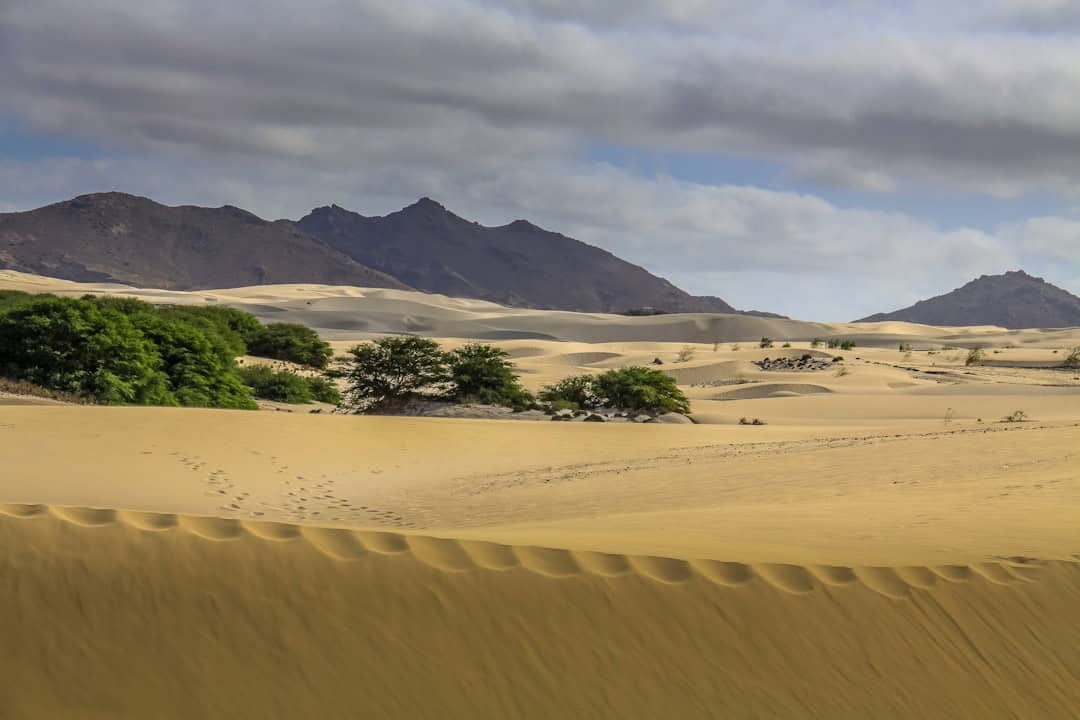
Photo by Nick Fewings
July Temperature Patterns
Daytime highs in July typically average around 29°C (84°F), creating a warm and sunny climate that is well-suited for beach activities, outdoor exploration, and water sports. The temperature can sometimes feel hot, especially during the peak of the day, but remains within comfortable bounds for most visitors.
Night-time lows settle at approximately 23°C (73°F), providing mild and pleasant evenings that are ideal for leisurely walks along the coastline or outdoor dining experiences.
July Rainfall Trends
July sees an increase in rainfall compared to preceding months, with short-lived showers becoming more common. Although the rain might be more frequent, it tends to be brief and isolated, rarely lasting long enough to significantly disrupt outdoor plans.
July Humidity Levels
With the influence of the Saharan air layer, humidity levels rise during July. The increased moisture in the atmosphere can be felt, particularly in areas sheltered from ocean breezes. While Cape Verde's characteristic dry climate persists to some extent, the rise in humidity might be noticeable compared to previous months.
July Marine Conditions
The sea temperature remains inviting for swimming and water-based activities, providing visitors with ample opportunities to enjoy the diverse marine life around the islands. Those interested in snorkelling or scuba diving will find the warmer waters conducive to underwater exploration.
The Saharan air layer can sometimes affect sea conditions, with stronger winds potentially creating choppier waters and affecting certain water sports activities.
July Wind Activity
The trade winds continue to influence weather patterns in July, though they may sometimes be stronger than in previous months. These winds play a role in moderating the heat and affecting sea conditions, contributing to the overall climate experienced across the islands.
July Sun Exposure
July continues to offer an abundance of sunlight, with long daylight hours providing ample opportunity for outdoor pursuits. With the sun higher in the sky and UV levels elevated, sun protection measures are essential to guard against overexposure.
July Natural Landscape
The rise in humidity and occasional rainfall can bring about changes in the islands' landscape as vegetation responds to increased moisture. This can create a refreshing greenery across some parts of the archipelago, particularly those that receive more rainfall.
For July travel to Cape Verde, pack lightweight and breathable clothing for warm days and bring something for cooler evenings. Include quick-drying garments and waterproof shoes due to humidity and potential rain. Sun protection such as high SPF sun cream, wide-brimmed hats, and UV-blocking sunglasses is essential. A compact umbrella or light raincoat could be helpful for showers. Casual evening wear is suitable for the warm nights. If you're keen on snorkelling or diving, consider bringing your gear to enjoy the marine life.
Cape Verde Weather in August
In August, Cape Verde experiences its warmest and wettest conditions as the islands are firmly entrenched in the wet season. Located off the coast of West Africa in the Atlantic Ocean, the archipelago's climate becomes influenced by the arrival of the Saharan air layer, bringing warmer and more humid weather.
August Temperature Dynamics
Daytime temperatures in August can reach their peak, often climbing to around 30°C (86°F). This creates a hot and sunny climate that is well-suited for beach activities, outdoor exploration, and water sports. The temperature can feel quite intense at times, especially during the middle of the day, but it remains within comfortable bounds for most visitors.
Night-time temperatures rarely drop below 24°C (75°F), providing warm and balmy evenings that are ideal for strolls along the coastline or outdoor dining experiences.
August Rainfall Patterns
August marks the wettest month in Cape Verde, although this designation is relative as rain showers are often brief and followed by sunshine. While rain showers become more frequent, they typically do not last long enough to significantly disrupt outdoor plans.
August Humidity Levels
With the influence of the Saharan air layer, humidity levels rise noticeably during August. The increased moisture in the atmosphere can be felt, particularly in areas shielded from ocean breezes. While Cape Verde's characteristic dry climate persists to some extent, the rise in humidity might be more pronounced compared to previous months.
August Marine Conditions
Sea temperatures are at their warmest in August, typically around 27°C (81°F). This provides an ideal opportunity for visitors to enjoy swimming and various water-based activities in the inviting waters surrounding the islands.
August Wind Activity
The trade winds continue to influence weather patterns in August, though they may sometimes be stronger than in previous months. These winds play a role in moderating the heat and affecting sea conditions, contributing to the overall climate experienced across the islands.
August Sun Exposure
August continues to offer an abundance of sunlight, with long daylight hours providing ample opportunity for outdoor pursuits. However, with the sun higher in the sky and UV levels elevated, sun protection measures are essential to guard against overexposure.
August Natural Landscape
The rise in humidity and increase in rainfall can bring about changes in the islands' landscape as vegetation responds to the added moisture. This can create a refreshing greenery across some parts of the archipelago, particularly those that receive more rainfall.
For August travel to Cape Verde, pack lightweight and breathable clothing for warm days and something for cooler evenings. Include quick-drying clothes and waterproof shoes due to increased humidity and potential rain showers. Sun protection such as high SPF sun cream, wide-brimmed hats, and UV-blocking sunglasses is essential. A compact umbrella or light raincoat could be useful for unexpected showers. Casual evening wear is suitable for the warm nights. If interested in snorkelling or diving, consider bringing your gear to explore the marine environment.
Cape Verde Weather in September
In September, Cape Verde experiences weather conditions similar to August, with warm temperatures and intermittent showers as the islands remain firmly within the wet season. Situated off the coast of West Africa in the Atlantic Ocean, the archipelago's climate is influenced by the arrival of the Saharan air layer, contributing to warm and humid conditions.
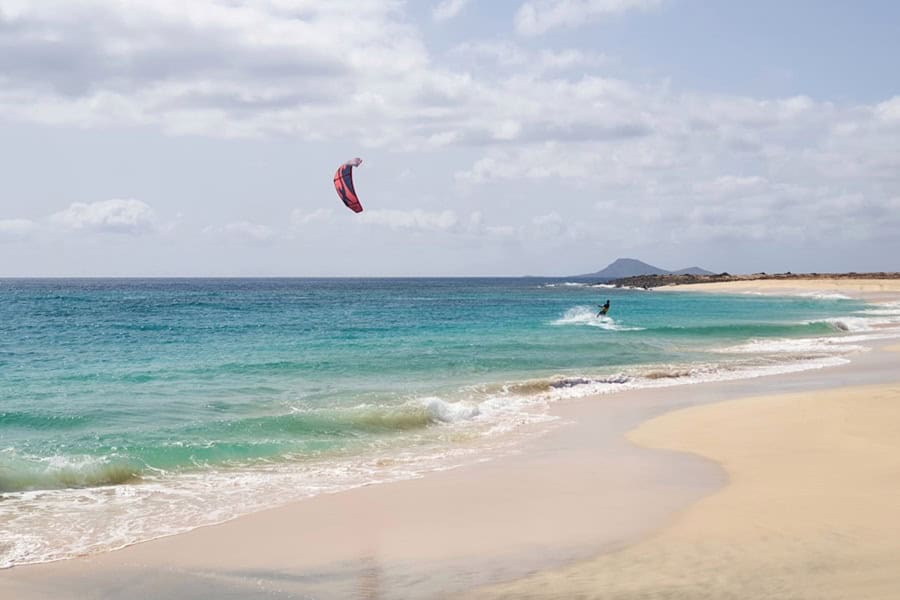
Photo by Christian Cacciamani
September Temperature Trends
Daytime highs in September average around 30°C (86°F), creating a hot and sunny climate that is well-suited for beach activities, outdoor exploration, and water sports. The temperature can feel intense at times, especially during the height of the day, but it remains within comfortable bounds for most visitors.
Evening lows hover around 24°C (75°F), providing warm and balmy nights that are perfect for strolls along the coastline or outdoor dining experiences.
September Rainfall Patterns
September sees occasional showers similar to August. While the wet season is ongoing, rainfall tends to be sporadic and short-lived, often followed by sunshine. These showers are typically brief and do not significantly disrupt outdoor plans.
September Humidity Levels
With increased precipitation during September, humidity levels are generally higher compared to the earlier months. The rise in moisture in the air can be felt, particularly in areas sheltered from ocean breezes. Despite this increase in humidity, Cape Verde's characteristic dry climate remains noticeable compared to many other tropical regions.
September Marine Conditions
Sea temperatures remain warm and inviting, providing an ideal opportunity for swimming and various water-based activities. The warmer waters are well-suited for snorkelling or scuba diving, allowing visitors to explore the rich marine life around the islands.
September Wind Activity
The trade winds continue to influence weather patterns in September. While they may sometimes be stronger than in previous months, these winds help moderate the heat and contribute to the overall climate experienced across the islands.
September Sun Exposure
September offers an abundance of sunlight, with long daylight hours providing ample opportunity for outdoor pursuits. However, with the sun higher in the sky and UV levels elevated, sun protection measures are essential to prevent overexposure.
September Natural Landscape
The rise in humidity and occasional rainfall can bring about changes in the islands' landscape as vegetation responds to increased moisture. This can create a refreshing greenery across some parts of the archipelago, particularly those that receive more rainfall.
For September travel to Cape Verde, pack lightweight and breathable clothing for warm days and something for cooler evenings. Include quick-drying garments, waterproof footwear, and sun protection such as high SPF sun cream, wide-brimmed hats, and sunglasses. A compact umbrella or light raincoat may come in handy for showers. Casual evening attire is suitable. If interested in snorkelling or diving, consider bringing your gear to explore the marine life.
Cape Verde Weather in October
In October, Cape Verde begins to transition out of the wet season, with weather conditions gradually becoming drier. Situated off the coast of West Africa in the Atlantic Ocean, the archipelago experiences a shift in its climate as it moves towards the end of the wetter period.
October Temperature Dynamics
Daytime temperatures in October remain high, typically ranging between 29°C (84°F) and 30°C (86°F). This creates a warm and sunny climate that is well-suited for beach activities, outdoor exploration, and water sports. The temperature can still feel quite hot during the daytime, providing ample opportunity for visitors to enjoy the island's natural beauty and outdoor activities.
Evening temperatures begin to cool slightly averaging around 24°C (75°F). This provides pleasant and comfortable evenings, perfect for relaxed walks along the coast or outdoor dining experiences.
October Rainfall Trends
October marks a decrease in rainfall compared to the peak of the wet season. While occasional showers may still occur at the beginning of the month, they become less frequent towards the end of October. The transition towards drier conditions is noticeable as the month progresses.
October Humidity Levels
With the reduction in rainfall, humidity levels also begin to subside as October unfolds. The decrease in moisture in the air can be felt, particularly in areas sheltered from ocean breezes. Cape Verde's characteristic dry climate gradually reasserts itself as the wet season wanes.
October Marine Conditions
Sea temperatures remain warm and inviting, providing an ideal opportunity for swimming and various water-based activities. The waters around the islands continue to offer favourable conditions for surfing, snorkelling or scuba diving, allowing visitors to explore Cape Verde's rich marine life.
October Wind Activity
The trade winds continue to influence weather patterns in October. While they may sometimes be stronger than in previous months, these winds help to moderate the heat and contribute to the overall climate experienced across the islands.
October Sun Exposure
October continues to offer an abundance of sunlight, with long daylight hours providing ample opportunity for outdoor pursuits. However, with UV levels remaining considerable, sun protection measures are essential to prevent overexposure.
October Natural Landscape
As the wet season draws to a close, changes in the islands' landscape become noticeable with a resurgence of greenery in some areas. The transition towards drier conditions initiates a transformation in the vegetation across the archipelago.
For October travel to Cape Verde, pack lightweight and breathable clothing for warm days and something for the cooler evenings. Include sun protection such as high SPF sun cream, wide-brimmed hats, and sunglasses. Casual attire is suitable for evening entertainment and dining. If interested in snorkelling or diving, consider bringing your gear to enjoy the marine environment.
Cape Verde Weather in November
In November, Cape Verde marks the beginning of the cooler and drier season, signifying a transition from the wetter conditions experienced in the previous months. Situated off the coast of West Africa in the Atlantic Ocean, the archipelago experiences a shift in its climate as it moves towards a period characterised by lower humidity and more moderate temperatures.
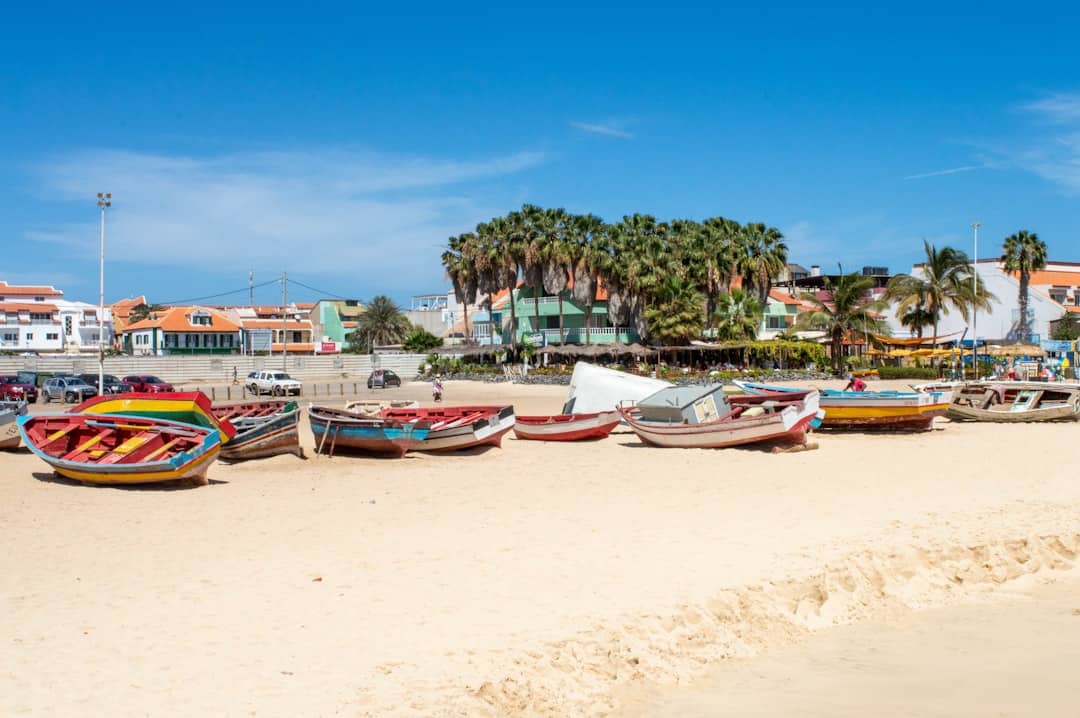
Photo by Florian K.
November Temperature Shifts
Average daytime temperatures in November begin to decrease slightly, settling around 28°C (82°F). While still warm, this decline introduces a more comfortable climate for outdoor activities, making it an ideal time for exploring the islands' natural beauty and partaking in various leisure pursuits.
Night-time temperatures can drop to approximately 22°C (72°F), resulting in cooler evenings that provide a refreshing break from the daytime warmth.
November Rainfall and Humidity
With the onset of the drier season, rainfall becomes infrequent, and humidity levels start to decrease. These changes contribute to the overall comfort of the weather, making outdoor excursions and beach activities even more enjoyable.
November Marine Conditions
The sea around Cape Verde remains warm enough for swimming and water-based activities, providing an appealing opportunity for visitors to engage in aquatic pursuits. While the sea temperature remains inviting, increased wind activity may affect certain water sports like surfing.
November Wind Activity
As the drier season commences, winds may pick up across the archipelago. This can affect sea conditions and beach activities, making it essential for water sports enthusiasts to be mindful of these changes.
November Natural Landscape
The transition into the cooler dry season may bring about changes in the islands' landscape as vegetation responds to the reduction in humidity. This can create a refreshed appearance across some parts of the archipelago, particularly those that receive less rainfall.
November Sun Exposure
November continues to offer ample sunlight for outdoor activities. However, visitors should remain mindful of sun protection measures, particularly during periods of extended sun exposure, when UV levels can still be considerable.
For travellers planning a visit to Cape Verde in November, a balance of clothing suitable for warm days and cooler evenings will be essential. Lightweight and breathable attire will cater to daytime excursions and beach activities while packing a light jacket or sweater may be prudent for cooler evenings. Sun protection items such as high-SPF sunscreen, wide-brimmed hats, and UV-blocking sunglasses should remain readily accessible for extended periods outdoors. Additionally, those interested in underwater activities may wish to bring their own snorkelling or diving gear to fully appreciate Cape Verde's rich marine environment.
Cape Verde Weather in December
In December, Cape Verde is fully immersed in the dry season, characterized by low humidity and generally pleasant weather. Situated off the coast of West Africa in the Atlantic Ocean, the archipelago experiences a climate that is conducive to a variety of outdoor activities and exploration.
December Temperature Dynamics
Daytime highs in December average around 26°C (79°F), creating a warm and comfortable climate for visitors. While still enjoyable, this marks a slightly cooler period compared to the previous months, providing a refreshing environment for outdoor pursuits.
Evening temperatures drop to about 20°C (68°F), making December one of the cooler months in Cape Verde. This presents a comfortable and mild ambience for evening strolls or al fresco dining experiences.
December Rainfall and Humidity
With the dry season in full swing, rainfall is rare, and humidity levels are notably low during December. This contributes to the overall comfort of the weather, making it an ideal time for outdoor adventures without the interruption of wet conditions.
December Marine Conditions
The sea remains inviting for swimming and water-based activities, with its calm and clear waters providing an attractive opportunity for visitors to engage in aquatic pursuits. Snorkelling, scuba diving, and leisurely swims can be enjoyed in the warm and tranquil ocean environment.
December Wind Activity
The trade winds continue to influence weather patterns during December, providing a gentle breeze that can enhance the overall comfort of outdoor activities. These winds also contribute to tempering the daytime heat and maintaining a pleasant climate across the islands.
December Sun Exposure
December offers an abundance of sunlight for outdoor activities. However, visitors should remain mindful of sun protection measures, particularly during periods of extended sun exposure when UV levels can still be considerable despite the cooler temperatures.
December Natural Landscape
The dry season brings about a distinct appearance to the islands' landscape, with vegetation responding to the arid conditions. This creates an opportunity to witness the unique beauty of Cape Verde's natural environment during this time of the year.
For travellers planning a visit to Cape Verde in December, packing should include a variety of clothing options to accommodate both warm days and cooler evenings. Lightweight and breathable attire will be essential for daytime excursions and beach activities, while including a light jacket or sweater would be prudent for cooler evenings. Sun protection items such as high-SPF sunscreen, wide-brimmed hats, and UV-blocking sunglasses should remain readily accessible for extended periods outdoors. Additionally, those interested in underwater activities may wish to bring their own snorkelling or diving gear to fully appreciate Cape Verde's rich marine environment.
Summary
The weather in Cape Verde is typified by a temperate tropical climate that oscillates between two primary seasons: the parched season and the wet season. The parched season, extending from November to July is characterised by lower humidity levels and an absence of rainfall, presenting perfect conditions for beach enthusiasts and those keen on outdoor pursuits. Concurrently, this period is also renowned for its winds, particularly from October to mid-July, which cools the atmosphere and provides optimal conditions for wind-driven water sports.

Photo by Timur Garifov
Conversely, the wet season from August to October is punctuated by sporadic yet intense downpours that revitalise the archipelago's flora. Nonetheless, Cape Verde's precipitation rates are relatively modest in comparison to other tropical environments.
Thermally, the islands experience a stable range throughout the year, with mercury levels hovering between 20°C to 30°C (68°F to 86°F). Altitudinal variations do bring cooler climes to mountainous regions such as Santiago and Santo Antão, while flatter islands like Sal and Boa Vista typically enjoy warmer and arider conditions.
To summarise, Cape Verde's climate is consistently mild with an enticing tropical warmth that beckons visitors year-round. The archipelago's weather patterns play a pivotal role in its allure, offering an inviting and varied backdrop that is conducive to a plethora of activities and experiences across its captivating islands. For specific forecasts, especially if planning travel or events, consult an up-to-date weather service.
FAQ
What is the weather like in Cape Verde?
Cape Verde enjoys a pleasant tropical climate with warm temperatures throughout the year. The weather is generally sunny and dry, making it an ideal destination for beachgoers.
What is the best time to visit Cape Verde in terms of weather?
The best time to visit Cape Verde is during the dry season, which runs from November to June. During this period, the weather is consistently warm and sunny, with minimal rainfall.
Does Cape Verde experience hurricanes or tropical storms?
Cape Verde is located in the Atlantic hurricane belt, and although hurricanes and tropical storms can occur, they are relatively rare. The peak hurricane season typically runs from August to October, but it's important to monitor weather forecasts if travelling during this time.
What is the average temperature in Cape Verde throughout the year?
The average temperature in Cape Verde varies between 24°C (75°F) and 30°C (86°F) throughout the year. It tends to be slightly cooler during the winter months of December to February.
How much rainfall can I expect in Cape Verde?
Cape Verde experiences a dry climate with low rainfall. Annual precipitation ranges from around 100mm (4 inches) in the coastal areas to approximately 300mm (12 inches) in the mountainous regions.
Are there any specific months to avoid visiting Cape Verde due to extreme weather conditions?
Cape Verde generally has mild and enjoyable weather year-round. However, if you prefer to avoid the hotter months, June to September can be quite warm, with temperatures occasionally reaching above 30°C (86°F).
What are the wind conditions like in Cape Verde?
Cape Verde is famous for its trade winds, which blow consistently from the northeast. These winds provide a cooling effect and make it a popular destination for windsurfers and kiteboarders.
Can I expect sunny days in Cape Verde all year round?
Yes, Cape Verde experiences a high number of sunny days throughout the year. Even during the rainy season, there are still plenty of sunny days to enjoy.
Are there any microclimates or variations in weather across different islands in Cape Verde?
Yes, there can be variations in weather across different islands in Cape Verde. Some islands may have more rainfall or slightly cooler temperatures compared to others. It's advisable to check the specific weather conditions for your chosen island before travelling.
Is it safe to swim and engage in water activities in Cape Verde considering the weather conditions?
Yes, it is generally safe to swim and engage in water activities in Cape Verde. However, it's important to be aware of any warnings or currents issued by local authorities and follow their guidance to ensure your safety.
Stay Updated Whilst Travelling
Ensure you remain informed on the most recent travel guidance from the Foreign, Commonwealth & Development Office by checking Travel Aware. This indispensable resource shares details on a variety of travel-related topics, such as safety and security, local legislation, currency, and health advice.
In addition, Travel Aware features a convenient Foreign Travel Checklist to help verify you've packed all the essentials for your trip. Bear in mind that travel recommendations can alter often, so regularly reviewing the latest information is vital.
Want more?
Sign up to our newsletter